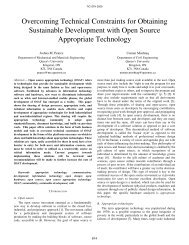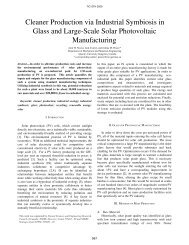Optimizing greenhouse gas mitigation strategies to suppress energy
Optimizing greenhouse gas mitigation strategies to suppress energy
Optimizing greenhouse gas mitigation strategies to suppress energy
You also want an ePaper? Increase the reach of your titles
YUMPU automatically turns print PDFs into web optimized ePapers that Google loves.
2nd Climate Change Technology Conference<br />
2ième Conférence sur les technologies du changement climatique<br />
May 12-15 mai 2009, Hamil<strong>to</strong>n, Ontario, Canada<br />
available source of estimations. Thus the range of growth rate limits and <strong>energy</strong> payback<br />
times can be set by no growth case and this maximum expected growth. For the high growth<br />
case, this enormous increase in <strong>energy</strong> demand represents a major challenge <strong>to</strong> current <strong>energy</strong><br />
infrastructure. Not only must the magnitude of the <strong>energy</strong> demands be met, but they must be<br />
met in a way which will avoid further CO 2 forcing of the climate system by overcoming the<br />
<strong>energy</strong> cannibalization effect. In this far more challenging case of both limiting fossil fuel<br />
combustion <strong>to</strong> 40% of the present, while allowing for growth in <strong>energy</strong> use <strong>to</strong> 24.8 G<strong>to</strong>e,<br />
renewable <strong>energy</strong> sources must increase by more than a fac<strong>to</strong>r of 100 by 2050. To do this,<br />
renewable <strong>energy</strong> sources will need <strong>to</strong> increase by 12% per year for the next 40 years. Energy<br />
cannibalism thus demands that the growth of the renewable <strong>energy</strong> sec<strong>to</strong>r be limited in<br />
aggregate <strong>to</strong> payback times of about 8 years. For many of the ETs under consideration this is<br />
not primarily a problem. For example, solar pho<strong>to</strong>voltaic cells generally have payback times<br />
under 5 years with most less than 2 years [21]. However, the balance of systems, or the way<br />
in which the solar pho<strong>to</strong>voltaic cells are deployed, e.g. a high canopy system consisting of a<br />
large quantity of steel can increase the payback time substantially.<br />
6. Discussion<br />
As the world focuses on methods <strong>to</strong> reduce fossil fuel combustion and the concomitant global<br />
climate destabilization, policy is often driven by concern over the economic costs for a given<br />
reduction in <strong>greenhouse</strong> <strong>gas</strong> emissions. As the climate system approaches a tipping point,<br />
such economic considerations must come behind physical laws. There are many examples of<br />
ETs that perform well from a net <strong>energy</strong> perspective, but fail <strong>to</strong> provide an attractive return on<br />
economic investments. High efficiency window retrofits, for example, have t EP of less than a<br />
year for many regions, but have economic paybacks measuring in years or even decades.<br />
Similarly, methods <strong>to</strong> reduce GHG emissions economically (as with highly subsidized nuclear<br />
power) may not make sense in high growth conditions needed (and lower ore grades are used)<br />
<strong>to</strong> supplant fossil fuels when <strong>energy</strong> cannibalism is considered) [12]. These results indicate a<br />
need for a move <strong>to</strong>wards of a global “<strong>energy</strong> economy” - an economy based on a real physical<br />
value of <strong>energy</strong> rather than on a subjective valuation of worth, in order <strong>to</strong> make informed<br />
decisions <strong>to</strong> ensure a stable climate for all nations and the biosphere. This can be<br />
accomplished using a number of mechanisms such as carbon credits [22], carbon trading [23],<br />
output-based allocations [24], carbon taxes [25], a shift <strong>to</strong> an <strong>energy</strong>-based economic system,<br />
and other methods discussed elsewhere including this conference. Regardless of the system<br />
used, the economic costs of <strong>energy</strong> need <strong>to</strong> be better aligned with the physical reality of<br />
<strong>energy</strong>. This challenges the market economy <strong>to</strong> adapt <strong>to</strong> fix the current market failure, which<br />
has driven investments in inefficient and polluting technologies for decades.<br />
7. Conclusions<br />
This paper has furthered preliminary work, which has shown that the GHG emission neutral<br />
growth rate of both <strong>energy</strong> conserving technologies and renewable <strong>energy</strong> technologies are<br />
constrained by the effects of <strong>energy</strong> cannibalism. To grow at the 7-12% rates needed <strong>to</strong><br />
stabilize the climate under <strong>energy</strong> demand increases, while remaining net GHG emission<br />
reducers, all ETs must grow at a rate slower than the inverse of their payback time (in<br />
aggregate








